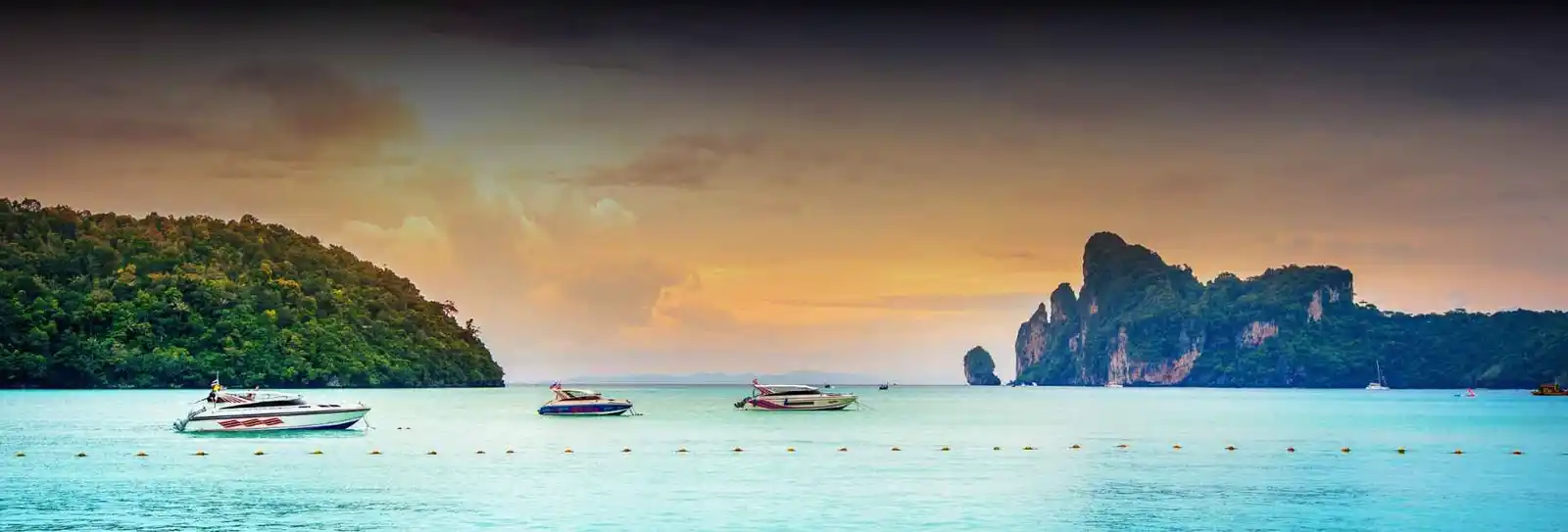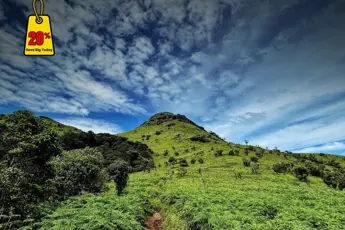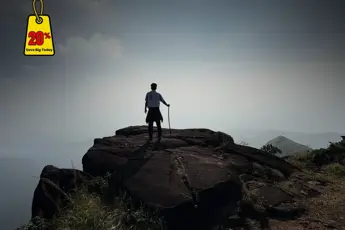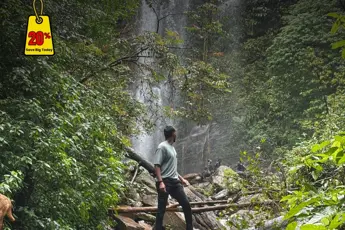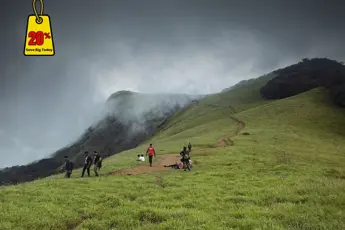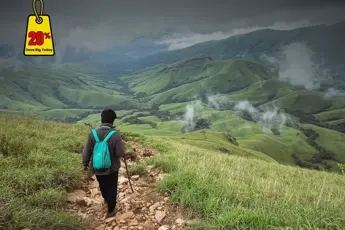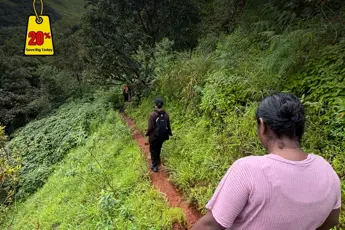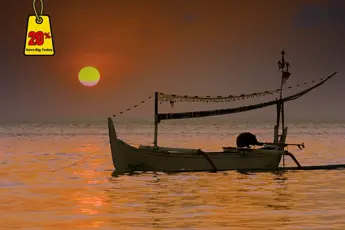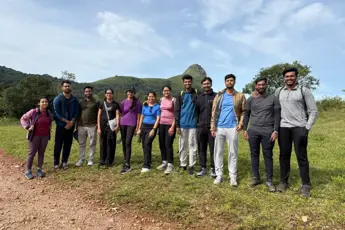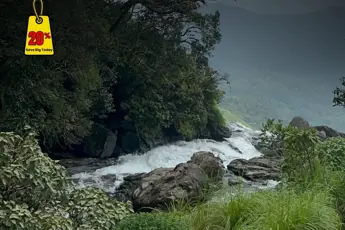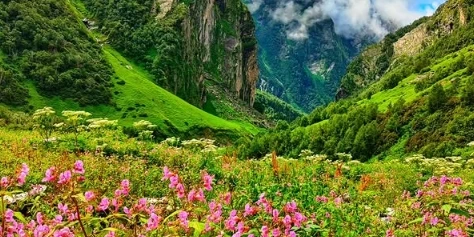
India's diverse landscape provides endless opportunities for trekking, most of which are suitable for family groups that want to spend time with each other in an active mode. Ranging from toddling around with toddlers to teenagers, the country is full of trails that are safe, scenic, and of middle grade, perfect for beginners and family treks. From the hill fog of Coorg to the snow scenes of Uttarakhand, these trekking excursions combine an interlude of nature and culture and an unforgettable experience.This well-researched compilation of India's Top 8 Family-Friendly Treks has trails such as Triund in Himachal Pradesh for its panoramic views and gentle gradient, and Rajmachi in Maharashtra, which interestingly provides history and fireflies during monsoons. Others like Yelagiri in Tamil Nadu and the floral delights of Dzukou Valley in Nagaland remain offbeat options. These treks are generally short, accessible from major cities, and suitable for kids aged 6 and above with basic fitness. Whether you’re seeking lush forests, mountain views, or a mix of both, these family treks ensure safety, fun, and lasting memories. Time to pack, strap in, and take the great outdoors, alas, a family outing.1. Valley of Flowers, UttarakhandIn the Chamoli district of Uttarakhand lies the Valley of Flowers, a World Heritage Site and India's most beautiful natural spectacle. It spans 87.5 square kilometres of the Nanda Devi Biosphere Reserve and is a Himalayan valley, 3,658 meters (12,000 feet) above sea level, which is laden with multicoloured alpine flowers during monsoons. The valley is paradise for nature lovers, a trekker's haven, a photographer's paradise, and heaven for a botanist. With over 500 flowering plants, rare medicinal herbs, and a beautiful landscape, it is a paradise for botanists and nature enthusiasts. It also has rare and threatened flora and fauna species.History of the Valley of FlowersHoldsworth when they got lost on their descent back from a mountaineering trip. Charmed by the valley's beauty, Smythe proceeded to write a book titled "The Valley of Flowers," which put it on the world map. It has been a national park since 1982 and a World Heritage Site as outlined by UNESCO in 2005. It is a religious site of Hindu mythology, as the site where Hanuman obtained the Sanjeevani herb for Lakshmana.Places to See around the Valley of FlowersHemkund Sahib: 6 km from the Valley, Hemkund Sahib is a sacred Sikh pilgrim site on a peaceful glacial lake at 4,329 meters.Ghangaria: Valley of Flowers and Hemkund Sahib base camp. Delightful small village with lodging and restaurant facilities.Badrinath: About 40 km, Badrinath is a Char Dham and a colossus pilgrimage centre.Joshimath: A transit town and starting point for several treks and religious places, Joshimath is also a staging post for an Auli cable car ride.Auli: Renowned for skiing and the views of the Nanda Devi range, Auli is a great spot to add to your return journey.Best Time to Visit the Valley of FlowersMonsoon Seas the on (July to August): The Valley of Flowers is at its best during the monsoon season, i.e., mid-August to mid-September. That is, when the valley is painted with every colour, because monsoon rain causes flowering. The green valley is blanketed by over 500 varieties of alpine flowers, including orchids, marigolds, poppies, and lilies. The leaves floating in the misty air create an otherworldly appearance to the scene. It is also trekking season, with clear paths and ideal conditions for the outdoors. Rain gear must be added, though, due to the showers characteristic of the monsoon period.Post-Monsoon (September to October): September to October is also a favourable visitation period since the rains of the monsoon start to subside. The flowers have not yet reached their full bloom, but the scenery remains green and beautiful. The weather is good, with mild breezes and blue skies, with beautiful sights of the surrounding mountains and valleys. The time is not the peak, therefore suitable for someone looking for a quiet trekking experience. If you can compromise with fewer flowers but also appreciate the blue sky and peaceful ambience, then it is a trekking time.Pre-Monsoon (May to June): Pre-monsoon season (May-June) can also be done, primarily by those who are not looking for the monsoon peak season. Although the flowers are not yet in their best, the valley is full of greenery and the trekking weather is good with pleasant temperatures and clear skies. You can trek through the entire area, get a glimpse of the view from a distance, and stroll silently through the valley. But the flowers will not be there, and there will be trails closed due to early-season snows.Winter (November to April): From November to April, the Valley of Flowers is closed to tourists due to heavy snowfall and harsh weather. The trekking routes are shut and the valley is snowed under. Even though the weather is not great for trekking, it's ideal for winter photography and snowfall enthusiasts to see the untouched charm of the area. Road access is poor, and it is not suggested to trek or travel during these months.How to Reach the Valley of FlowersBy Airport: The nearest airport is Jolly Grant Airport, Dehradun, near Govindghat (trek point), 295 km away. Facility available here is a taxi to Joshimath or Govindghat from the airport.By Rail: The nearest railway station is Rishikesh, which is 273 km from Joshimath/Govindghat. Take a cab or bus and go to Joshimath/Govindghat.By Road: Govind Ghat is well linked by road with Dehradun, Haridwar, and Rishikesh. Buses and shared taxis are available from these towns to Joshimath and then going further up one can drive up to Govindghat.2. Pahalgam to Aru Valley, KashmirPahalgam to Aru Valley trek is arguably the most scenic and fascinating of all treks in Kashmir's valley. Renowned for its emerald pastures, blue gushing streams, and snow-topped high peaks, the trek is a serene and refreshing experience for nature lovers and adventure tourists alike. Starting from the scenic town of Pahalgam, a distance of about 95 kilometres from Srinagar, the trek traverses dense forests, virgin valleys, and small villages, before it finally enters the serene Aru Valley. This is a relatively easy family and beginner trek, and can be completed in 3-4 days.History of Pahalgam to Aru ValleyEven though the trekking trail from Pahalgam to Aru Valley is well known for its natural beauty, the region is culturally and historically significant in itself. Pahalgam was a small village earlier and was an earlier base camp for pilgrims visiting the Amarnath Cave. It has remained a favourite with tourists for many years now, appreciated for its magnificence and serene vistas. Aru Valley is relatively unexplored and untainted, and it is therefore the ideal place to go for wanderers who are looking to distance themselves from the chaos of the masses. The valley comprises some Kashmiri and old villages and houses that offer the trekkers a chance to experience local civilisation and culture.Nearby Places to Visit: Pahalgam to Aru ValleyBetaab Valley: Known for its natural scenery and Bollywood movie shoots, it is easily accessible from Pahalgam by road.Chandanwari: A leading Amarnath Yatra starting point and 16 km from Pahalgam, and renowned for its peaceful scenery.Baisaran: Also called "Mini Switzerland," it's a beautiful meadow with an overview of the hills around.Lidder River: Runs through Pahalgam and is perfect for fishing, rafting, and a leisurely walk by the river.Best Time to Go to Pahalgam to Aru Valley, KashmirSummer (May to June): Summer, May and June, is taken into consideration as the ideal time to go on the Pahalgam to Aru Valley trekking tour. It is during this season that the weather is warm and pleasant, between 1°C and 25°C. The valley is green with dense grasses and can be accessed easily by the trekking trails, and not at all chilly. It is best for those trekkers who do not wish to trek in monsoon rains and want a peaceful trekking experience with unlimited sunshine and lovely green meadows. The melting of the snow also contributes to the scenic beauty of rivers and waterfalls along the route.Monsoon (July - September): Aru Valley during monsoon (July - September) is bestowed with green views and scenic beauty, with the possibility of rain. Flowers are blooming everywhere in the valley, yet the routes are slippery and muddy, hence the trek becomes slightly tough. If you enjoy rain trekking and do not mind getting wet, then this can be a good time to visit, as the valley looks very green. But do expect heavy showers, and it is better to carry waterproof accessories and proper trekking gear.Autumn season (September to October): By this time, the monsoon rains have disappeared, and the climate is good with clear blue skies and cold winds. The landscape begins to change, and the meadows and forests attain warm yellow, orange, and red hues. This is the perfect time to go trekking as the path is not damp and the weather is just good enough to stay out in the rural surroundings. The silent and calm ambience also makes a peaceful trekking experience because the monsoon madness fury is over.Winter (November to February): The Winter season (November to February) in Aru Valley provides a completely different experience. The valley is snowed under heavily, and it's a sparkling winter wonderland. Hiking at this time is quite difficult with freezing temperatures, snowy paths, and potential road closures because of heavy snowfall. The area is less accessible at this time, with most of the roads closed. While winter may be enchanting to people who love snow and to photojournalists, it is hardly the most suitable season for trekkers since it comprises harsh weather along with security risks.Spring (March-April): It is that time of the year when there are pleasant weather conditions in Aru Valley, with snow melting and the first flowers already blooming in the valley. Though flowers have not yet begun blossoming, it is a very quiet time before the summer travellers’ arrival there. The weather is cool and cold between 5°C and 15°C, ideal for short walks and nature strolls. Part of the tracks are even challenging as the snow will still have covered them, and therefore best to ask first about trail conditions before going there.How to Reach Pahalgam to Aru Valley, KashmirBy Airport: Sheikh ul-Alam International Airport, Srinagar, is the closest airport (95 km from Pahalgam).By Train: Srinagar Railway Station is the nearest large railway station, and one can get a taxi or bus from there.By Road: Pahalgam is also connected by road to Srinagar well. It's a 2-3 hour, 95 km journey and can be done by state buses or taxis.Trek Start Point: Trek from Pahalgam, 12 km away. Trek passes through dense forest, over lovely meadows, and along gentle slopes, with grasslands and river-side camps.3. Tirthan Valley, Himachal PradeshAmidst the Himalayas is Himachal Pradesh's Tirthan Valley, a peaceful and picturesque destination, strategically located for tourists looking for peace, adventure, and a hint of unspoiled nature. Approximately 60 km from Kullu and 150 km from Chandigarh, Tirthan Valley is famous for its greenery, clean rivers, and villages. The valley is commonly referred to by the name of the river Tirthan, which runs through it and graces the place with its serenity and natural beauty. Famous for off-the-tourist-circuit trekking trails, verdant greens and wildlife, and warm homestays, Tirthan Valley is off the tourist circuit compared to Himachali hill over-toured stations. Whether you are an adventurer or simply looking for peace in the warm, cosy arms of nature, Tirthan Valley has something to offer you.History of Tirthan Valley, Himachal PradeshTirthan Valley, like the rest of Himachal Pradesh, abounds in history and culture. The valley consists of several small villages where the villagers practice traditional farming and weaving. The Tirthan people are known to be very friendly, and staying in their houses provides an insight into real rural life in the region. The most picturesque place in the region is the Great Himalayan National Park (GHNP), a World Heritage Site. The park is famous for its cultural heritage along with its extremely high level of biodiversity, and is one of the most striking aspects of the valley's nature. It also holds religious importance as the Tirthan River has been given a name after a pilgrim route alongside it, giving the area spiritual importance.Places to Visit Around It: Tirthan Valley, Himachal PradeshGreat Himalayan National Park (GHNP): A UNESCO World Heritage Site with good flora and fauna, best suited for nature enthusiasts and trekkers.Thirthan Valley: A picturesque and serene village located close to Tirthan Valley, renowned for waterfalls, pristine rivers, and lovely meadows.Sainj Valley: Off-beat treasure close to Tirthan Valley, with lush forests and serene ambience for trekking and nature enthusiasts.Chhoie Waterfall: Panoramic waterfall at a distance of a few kilometres from the valley, ideal for a short trek and photography.Shoja: It is a quiet village close to Tirthan, famous for being surrounded by a calm atmosphere and a trekking base camp for treks like the Serolsar Lake trek.Best Time to Visit Tirthan Valley, Himachal PradeshSummer (March to June): Summer is the best time for valley trips, trekking, and camping. It offers the most favourable climatic conditions of 15°C to 30°C, thus offering the finest time for any outdoor activity like river angling, forest treks, and wildlife safaris within the Great Himalayan National Park.Monsoon (July to September): Monsoon will have the valley green and colored, but rivers will be high, and there will be slippery tracks. It is an adventure tourist off-season for monsoon season lovers because there are few tourists. It is not ideal to trek or participate in other outdoor activities, though, because landslides may take place.Autumn (October-November): It is one of the best seasons to travel to the valley. The climate is pleasant and cool with clear blue skies, the best for hiking and sightseeing. The autumn foliage also provides a splash of beauty to the landscape, and the valley is at its best then.Winter (December to February): Snow wonderland, Tirthan Valley, snow-covered valley, particularly at higher elevations, and snow heaven for the snow enthusiast. Though pre-booking and caution in front of snow-clad trails may be the destiny of the trekkers during this time, there is something unspoken to the camera and skis about virgin landscape.How to Reach Tirthan Valley, Himachal PradeshBy Airport: Nearest airport, Bhuntar Airport (60 km) from Kullu, is nearest to Tirthan Valley. A taxi can be hired from there to the valley.By Train: The nearest railway station is Joginder Nagar, which is 120 km from Tirthan Valley. Or else one can go up to Chandigarh Railway Station (150 km from Tirthan Valley) and take a taxi or bus to the valley.By Road: Tirthan Valley is easily accessible by road from Manali, Kullu, and other major towns of Himachal Pradesh. The valley is by road only 2 hours from Kullu. Tourists can even travel by bus or travel by taxi from nearby towns to the valley.4. Mawlynnong, MeghalayaDotted with the picturesque Meghalaya hills, Mawlynnong is a picturesque village that has been officially declared Asia's cleanest village. Mawlynnong is located about 90 kilometres from Shillong, the capital of Meghalaya. This tells it all about the villagers' sense of discipline, hard work, and sheer affection for nature, the majority belonging to the Pnar tribe. Famous for fresh air, green surroundings, and green living, Mawlynnong is a serene haven for those who look for a world-class quiet holiday. Foreigners can benefit from the ambience of green trees, multi-colour flowers, and a green lifestyle which distinguishes the village from which pay heed to nature in a nation where the green issues have a growing mass following.History of Mawlynnong, MeghalayaMawlynnong is full of the heritage of Pnar tribe culture and Meghalaya's indigenous people. The village exists in perfect harmony with nature and the environment through a mix of traditional Khasi culture and green living. The villagers, under the leadership of their headman, work on stringent sanitation rules, garbage disposal, and environmentally friendly behaviour for which they have been rewarded globally. The clean and well-maintained surroundings of the village serve as an inspiration to other places within and around it, which also serve as inspiration to other locations. Mawlynnong is also spiritually and culturally advanced, and there are numerous small shrines and sacred groves throughout the village, demonstrating the high religious beliefs of the locals. Places to Visit near • Living Root Bridge: The living root bridge, constructed using the living roots of trees, is at a 30-minute drive from Mawlynnong and is a breathtaking representation of the ingenuity of the local people, that is, the Khasi people.Nearby Places Mawlynnong, MeghalayaDawki: Dawki, just 30 km from Mawlynnong, is famous for the crystal clear water of river Umngot River, because of which boating in mid-air appears to be an illusion there.Shnongpdeng: Village at the outskirts of Dawki, also a favourite for boating and kayaking sports activity at the transparent water of the Umngot River.Jowai: Jowai is the headquarters of West Jaintia Hills and is marked by landscape scenes, waterfalls, and caves and surely day outing from Mawlynnong.Best Time to Visit Mawlynnong, MeghalayaMonsoon (July to September): Although the monsoon is lush with vegetation, it rains quite heavily in the village and the surrounding areas as well, which may cause landslides and difficult trekking. But if you like monsoon mist and fresh, spirited air, there is another beauty to the village at this time.Autumn (October to November): It is also suitable for traveling since the scenery is not yet dry and changing colors, and the weather is not extreme, thus one can go for a walk or roam about freely. The air is fresh and pure with the sky being free from pollutants, ideal for photography and long walks around the village.Winter (December to February): This is winter in Mawlynnong when it is characterised by cold weather ranging from 5°C to 15°C. Off-season visit to the village with very low temperatures, such that the region is full of fresh and clean air. This is a place where one can experience quietness during this time, hence the perfect place for any individual searching for calmness and silence.How to Reach Mawlynnong, MeghalayaBy Airport: Nearest airport is Shillong Airport (Umroi) approximately 85 km from Mawlynnong. The alternative is Lokpriya Gopinath Bordoloi International Airport at Guwahati (170 km) from where there are a number of connecting flights from important Indian cities.By Train: The nearest train station is Guwahati Railway Station, which is approximately 160 km from Mawlynnong. You can take a bus or a taxi from the station to the village.By Road: Mawlynnong is also an easily accessible location by road from Shillong (90 km). Private cabs, buses, or shared cabs can be hired to reach the village. Mawlynnong has decent roads for the most part, though the drive could be slightly rough here and there because of the hilly terrain.5. Rajmachi Fort Trek, MaharashtraRajmachi Fort Trek is one of the most sought-after treks in Maharashtra with a fantastic mix of history, nature, and adventure. Rajmachi Fort lies at an altitude of 2,710 feet and is located in the Sahyadri range of mountains with a stunning view of the picturesque Konkan village. The trek begins from the base village of Udhewadi, 15 km from Lonavala. The fort is made up of two forts, Manaranjan Fort and Shrivardhan Fort, and provides stunning sightseeing of the waterfalls, valleys, and lush forests surrounding the entire vicinity. Because it is a low-lying, gentle area, the Rajmachi Fort Trek is ideal for beginners, history buffs, and families, as it is an easily accessible trek. The hike is possible over the weekend or within a day, and this is convenient since it's a perfect option for a weekend getaway from the city.History of Rajmachi Fort TrekRajmachi Fort is historically significant, dating back to the 17th century. The fort was originally built by the Chhatrapati Shivaji Maharaj as a defensive fort to keep the incoming foes at bay and also to be in control of the area around it. The fort was of help during the Anglo-Maratha wars. It has been a trekking destination for a long time due to both its location and due to being historical importance. Rajmachi Fort remnants are also preserved well, consisting of ancient structures, gateways, and tanks. The fort reflects the methods used by the Marathas to construct defensive buildings, which manifest their building expertise as well as their wise minds.Places to Visit Around Rajmachi Fort TrekJonavala: One of the well-known hill stations close to Rajmachi, known for its beauty, caves, and lakes. 15 km away from Rajmachi, it offers the experience of Bhushi Dam, Tiger's Leap, and Karla Caves.Kune Waterfalls: Approximately 10 km from Lonavala, Kune Waterfalls are among the highest waterfalls in Maharashtra and a renowned picnic and nature walk destination.Lohagad Fort: Ancient fort in close distance of Rajmachi, Lohagad is a moderately demanding trek and provides a view of Maharashtra mythology.Bhaja Caves: Ancient rock-cut Buddhist caves near Lonavala, providing a look into Maharashtra culture and heritage.Best Time to Travel Rajmachi Fort TrekMonsoon (June to September): Best time to visit Rajmachi Fort. The whole area is in its full bloom during the monsoon with the thick forests, thundering waterfalls, and misty mountains. The roads get a little slippery, thereby making the whole experience all the more thrilling. Although the monsoon is a wonder ride with the valley in its full bloom, precautions should be taken while driving on the slippery roads and proper gear should be worn.Winter (October to February): Winter (October to February) is ideal to do trekking as the weather is clear and cold, and the trekking is good. The weather is cold and dry, and the tracks are dry, ideal time to experience a silent trek. The weather is 10°C to 25°C, the best time to do day trekking and night camping at the fort.Summer (March to May): Summer is excessively hot with the max temperature at 35°C but the trek is not possible. If equipped with proper gears, effective provision of water, caps, and sun protection, you may attempt the trek without experiencing the tourist rush of the peak monsoon season. In summer season view is not as romantic as during rainy or winter season though.How to Reach Rajmachi Fort TrekOn Road Journey: Rajmachi Fort is approximately 70 km from Pune International Airport. Pune to Lonavala and Rajmachi Fort is available by taxi or bus.On Road Journey: Lonavala station is the nearest railway station, well connected from metro cities Pune and Mumbai. Udhewadi base village is easily accessible from Lonavala by trek or taxi.By Road: It can also be approached by road from both Mumbai (approximately 80 km) and Pune (about 70 km). Drive or take a local jeep all the way down to the base village of Udhewadi from Lonavala.6. Triund Trek, Himachal PradeshTriund Trek in Himachal Pradesh is probably the most accessible and easily available trekking destination within the Dhauladhar range of Dhauladhar. At an altitude of 2,827 meters (9,275 feet), Triund offers the trekker a breathtaking view of the towering Dhauladhar range to the north and the Kangra Valley to the south. Triund is appropriate for beginners and old-timers alike in the sport and is graded as short in distance and moderate. It means walking through forest cover, boulders, and grass meadows and an experience to cling to for all. The serenity of the mountains that surround it, especially morning and evening, makes Triund an ideal weekend destination for adventure seekers as well as nature lovers.History of Triund TrekAlthough Triund is renowned for its natural beauty, the location is of historical and cultural significance too. The Dhauladhar Range, to which Triund deems itself to be, is Himachal Pradesh's cultural and spiritual heritage. The journey is through Kangra Valley, a historically renowned region of Kangra Valley Temples for centuries. Triund trek is even a pilgrim travel due to the serenity and quiet it provides amid nature's embrace. Furthermore, the McLeod Ganj neighbourhood near the trekking location is the Dalai Lama's domicile and a region full of Tibetan Buddhist cultural history.Places of Interest near Triund TrekMcLeod Ganj: McLeod Ganj, lying just 9 km away from Triund, is India's cultural hub of Tibetan culture and the Dalai Lama's domicile. The town is famous for monasteries, Tibetan markets, and religious vistas.Bhagsu Waterfall is a serene waterfall and is 2 km away from McLeod Ganj. The waterfall is a pleasant place where an individual can sit and relax and experience the natural ambience.Namgyal Monastery: A Tibetan Buddhist monastery in McLeod Ganj. It is a place where an individual can sense a serene environment and study Tibetan Buddhism.Kangra Fort: 20 km from McLeod Ganj. This is one of the oldest forts in India and a history enthusiast's top pick.Kareri Lake: 13 km from Triund, this lake at a high altitude is perfect for trekking folks who enjoy tough treks and stunning vistas.Best Time to VisitSummer (March to June): Summer season is ideal for the trek to Triund. Warm and pleasant weather of 15°C to 25°C ideal for a day's outing. The path is easily accessible and the view new and breathtaking. Beginners would enjoy the trek or camp tour most during the summer.Monsoon (July to September): Although monsoon does boast great green scenery and half-colored hues, it does experience heavy rains, and that makes the trekking scenario relatively less inviting. The roads are slushy and wet, and landslides here, too, become an issue, so the destination is relatively less trekker-friendly. It is quite feasible to have one fewer tourist to have an off-the-beaten-path, serene trekking experience, but safety measures need to be adopted.Autumn (October to November): The Autumn season is also good for trekking. It's pleasant and warm from 10°C to 20°C, with clear blue skies, and some great views of the Dhauladhar ranges and the Kangra valley. It is the best time to visit Triund since the trek is dry and the paths are flowering.Winter (December to February): This is the most difficult season to trek to Triund since the area receives heavy snowfall and the temperature drops below freezing point, particularly at night. While the winter landscape is stunning and peaceful, winter treks need to be undertaken with experience and prior knowledge. If you are a snow trekker and prefer temperatures lower than the freezing point, then winter would be magical, but only for expert trekkers.How to Reach Triund TrekBy Airport: Dharamshala Gaggal Airport, 15 km from McLeod Ganj and 30 km from Triund base camp. You can get domestic flights from all the big cities like Delhi and Chandigarh from there. Take a taxi from there to the trekking point.By Train: Pathankot is the nearest railhead, 90 km from McLeod Ganj. A taxi or a bus can be hired from Pathankot to Dharamshala or McLeod Ganj.By Road: Triund is also well connected by road to the metropolitan towns of the city. Dharamshala, the nearest big town, is 9 km away from the trekking starting point. Taxis and buses are an easy mode of transport from Dharamshala to McLeod Ganj and the trekking starting point to Triund.7. Nag Tibba Trek, UttarakhandNag Tibba Trek is among the most popular trekking destinations in Uttarakhand, through which the trek members witness the beauty of nature in the Garhwal Himalayas. Nag Tibba is at a height of 3,022 meters (9,915 ft) in the Tehri Garhwal range, and the drive to reach the destination by car is the favourite of relatives, first-time trekkers, and nature lovers. The hike provides breathtaking views of Himalayan snow-capped mountains such as Nanda Devi, Trishul, and Swargarohini, and is a delight to be relished. The hike is conveniently linked with Dehradun and Mussoorie and can be completed in 2-3 days, and hence makes a perfect weekend outing.History of Nag Tibba TrekNag Tibba or Serpent's Peak also holds enormous religious and cultural significance locally. The summit is dedicated to Nag Devta, the snake god, as is believed by the local inhabitants, who is said to safeguard the place and its inhabitants from disaster. The trek will traverse forests, old temples, and villages and give a glimpse into the lifestyle and culture of the area. The trek is a much-desired one in the days of the festival of Nag Devta, and the pilgrims, as well as the locals, complete the trek up to the summit to make their offerings. The region is also blessed with the rich cultural riches of animal husbandry and agriculture, where the residents have chosen the green method of means of centuries.Nearby Places to Visit on the Nag Tibba TrekMussoorie: More popularly referred to as the "Queen of Hills," Mussoorie is a hill resort with scenic vistas at around 35 km from the foot of the Nag Tibba Trek. Its colonial design, its scenery, and proximity to such visiting spots as Kempty Falls and Camel's Back Road make Mussoorie the perfect place to relax prior to or after the trek.Dehradun: The state capital, Dehradun, is 60 km from Nag Tibba and is the point of origin of high-altitude treks in the area. Robber's Cave, Mindrolling Monastery, and Sahastradhara waterfalls are accessible here.Har Ki Dun: Har Ki Dun is one of the most demanding Garhwal Himalayan treks, which should be embarked upon by experienced trekkers. The valley is 50 km away from Nag Tibba and possesses beautiful views of endless landscape, alpine grasslands, and old villages.Rajaji National Park: Rajaji National Park, 40 km from Nag Tibba, is among the prime places for people interested in biodiversity and a nature walker’s heaven. It is mentioned to have elephants, birdwatching, and nature walks.Best Time to Visit Nag Tibba TrekSummer (March to June): Summer season is the ideal period for trekking in Uttarakhand since temperature ranges from 12°C to 20°C, and trekking and camping are excellent and beautiful. Blue sky and lush green forests are just ideal for trekking. Summer season trekking and camping are ideal because nights provide great starry night sky.Monsoon (July to September): Steer clear of the monsoon season since the rains make the trails slippery and hard to walk on. There is a chance of landslides and leeches also increasing, making it challenging for trekkers. If you’re looking for a quiet, off-season experience, the monsoon can offer lush, misty landscapes, but the trails can become dangerous.October to November (Autumn): Autumn season is also ideal to trek Nag Tibba. Weather is lovely with blue sky and congenial temperature of 10°C to 15°C. Mountains are white with snow and it is clear. Weather is ideal for those who prefer serene trek without any hindrance.Winter (December to February): Winter is a thrilling choice for a snow trek and the experience of enduring cold. Snow in the winter season falls in the region, with subzero temperatures, particularly at night. Snow-covered landscapes are peaceful and beautiful, but proper planning has to be in one's mind to take on a winter trek.How to Reach Nag Tibba TrekBy Airport: Jolly Grant Airport in Dehradun, closest to Nag Tibba, is 75 km. It is properly connected with other big cities like Delhi and Mumbai. Taxi service from the airport up to the trekking point is available.By Rail: Nearest railhead is Dehradun Railway Station, 70 km from the trekking start point. Frequent trains operate from and to all major Indian cities to Dehradun. A taxi or local bus facility can be accessed from the railway station to the trekking start point.By Road: Trekking base, Pantwari village, is accessible by road from Mussoorie (35 km) or Dehradun (70 km). A local taxi or a Mussoorie/Dehradun bus will drop you at Pantwari. Roads are motorable, and the drive is on scenic roads.8. Binsar Wildlife Sanctuary Trek, UttarakhandBinsar Wildlife Sanctuary is a virgin paradise of Uttarakhand, providing trekkers with a glimpse of the fauna and flora of the state. Located in Almora District, 2,420 meters (7,940 feet) above sea level, the sanctuary is in the mid-Himalayan area. Binsar Trek is hiking through deodar, oak, and rhododendron woods and otherworldly landscapes of the white peaks of Nanda Devi, Trishul, and Panchachuli. The sanctuary lies over an area of 45.59 square kilometres of land and is blessed with a healthy population of wildlife such as bears, leopards, deer, and other birds. It is the finest mid-level trek for nature trekkers, wildlife enthusiasts, and adventure enthusiasts to experience the wilderness of Uttarakhand. It can be done within 2-3 days, and hence it is the most suitable destination for a weekend tour.History of Binsar Wildlife Sanctuary TrekBinsar Sanctuary is naturally and historically important. Binsar Wildlife Sanctuary was formed in 1988 to conserve the region's special wildlife and natural flora. The area is biologically diverse and has also been a major contributor to Uttarakhand's cultural wealth. The area is country-famous temples, i.e., the Binsar Mahadev Temple, i.e., Lord Shiva temple. The sanctuary has been a centuries-old worship place, and nature lovers as well as pilgrims visit the area. The region is also renowned for its ancient cultural association with the native Garhwali and Kumaoni inhabitants, who have existed in harmony with nature for centuries.Places to Visit Near Binsar Wildlife Sanctuary TrekAlmora: Almora is approximately 30 km from Binsar and is a picturesque hill station renowned for its beauty, cultural importance, and old temples. Explore the Kasar Devi Temple, Chitai Golu Devta Temple, and the Bright End Corner to view the Himalayas from a bird-eye perspective.Jageshwar: Jageshwar, an age-old temple complex of times immemorial and Lord Shiva's abode, is situated around 40 km from Binsar. This temple, surrounded by forestlands, is a tranquil refuge for those who seek nature and spirituality.Kausani: It is approximately 50 km from Binsar and is a peaceful hill station with a magnificent view of the Himalayan ranges like Nanda Devi, Trishul, and Panchachuli. Even Mahatma Gandhi lived here and documented his experience in the area.Nainital: Nainital hill station is about 90 km from Binsar and features such wonders as Naini Lake, Snow View Point, and Tiffin Top. It's perfect to unwind after completing the trek.Best Time to Visit Binsar Wildlife Sanctuary TrekSummer (March to June): Summer can also be visited to Binsar Wildlife Sanctuary. Weather is pleasant and warm with temperature ranging between 15°C to 25°C, the best time to go trekking. Blue skies and greens make the trek all the more romantic. Summer season is the perfect time to view wildlife since animals congregate near water bodies.Monsoon (July to September): Monsoon can be avoided since the rains are copious and trails become slippery and hazardous. Landslides cannot be ruled out, and trekking within the sanctuary is not advised. However, if misty and tranquil environments are sought after, then monsoon is ideal with a landscape of greens.Autumn (October to November): Even the autumn is apt to relax at the sanctuary too, with clear blue sky, pleasant cool breeze, and open view of snow mountains. Pleasant cool climatic conditions between 10°C to 20°C and dry trails suitable for trek.Winter (December to February): Winter provides a fairy-like appearance to the Binsar Wildlife Sanctuary because the place receives snowfall earlier. The temperature drops below the freezing point, especially night, and snow-clad peaks provide a treat to the eyes. If you are a snow trekking lover and focused, winter months are worth watching, but require proper planning.How to Reach of Binsar Wildlife Sanctuary TrekBy Airport: The nearest airport to Binsar is Pantnagar Airport, which is approximately 130 km from there. You can travel to the base of the trek by air from there.By Train: The nearest railway station to Binsar is Kathgodam, at a distance of 115 km. Kathgodam is readily accessible from Delhi city, and from there you can go in a taxi or local bus till the trek point.By Road: Binsar is also well accessible by road to the other Uttarakhand towns. The nearest towns are Almora (30 km) and Nainital (90 km), to which you can drive a taxi or a local bus till the gateway point of the sanctuary. The metalled roads are excellent, and the drive itself is excellent with scenery.Why Book with escape2exploreWhen exploring two-day trips from Bangalore and beyond, escape2explore stands out as a trusted name in adventure and experiential travel. Here’s why hundreds of travellers choose us for their getaways:Trusted, Well-Reviewed Local Operator: escape2explore has gained the trust of thousands of content tourists all over India. With persistent positive feedback and an unblemished reputation for delivering quality experiences, we assure you that your experience will be hassle-free, memorable, and value-packed. Our insider local knowledge guarantees that you will always be in safe hands.Seasoned Guides: Our trips are led by friendly, trained, and professional guides who are passionate about the outdoors and your safety. Whether it's a beach trek, a cultural tour, or a spiritual walk through temples, our team knows the terrain, the stories, and how to make each moment count.Safe & Curated Itineraries: Your safety is our number one priority. Our tour packages are thoughtfully crafted with safety measures, researched accommodations, and easy travel arrangements. We take care of the details so you can have the experience hassle-free and worry-free.Unique Experience That You Won't Find Anywhere Else: With escape2explore, you discover more than the tourist attractions. We go off the beaten track with hidden beaches, unusual treks, offbeat cultural destinations, and true interactions.Read: Friendly Trekking in India | Trekking Guide | Hidden Treks of Karnataka | Everest Base Camp Guide |Netravati vs Kudremukh


